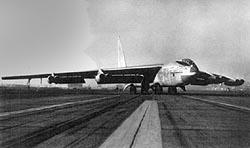What Is a Crosswind Landing?

B-52 performing a crab landing having
nose pointed toward incoming wind, but
undercarriage aligned along the runway.
|
A crosswind landing is a landing maneuver in which a significant component of the prevailing wind is perpendicular to the runway centerline.
Aircraft in flight are subject to the direction of the winds in which the aircraft is operating. For example, an aircraft in flight that is pointed directly north along its longitudinal axis will, generally, fly in the that northerly direction. However, if there is a west wind in the air in which the aircraft is flying, then the actual trajectory of the aircraft will be slightly to the east of north. If the aircraft was landing on a northbound runway, it would need to compensate for this easterly component of velocity caused by the west crosswind.
In a cross wind landing the wind will push the aircraft off of runway alignment unless the pilot takes corrective action. Obviously, the greater the angle of the wind in reference to the runway the greater the impact on aircraft drift. If the pilot of the landing aircraft does not take any corrective action the aircraft will either land off of the runway, or will touch down while the aircraft has a sideways motion. This sideways motion can result in loss of control or damage to the landing gear.
|